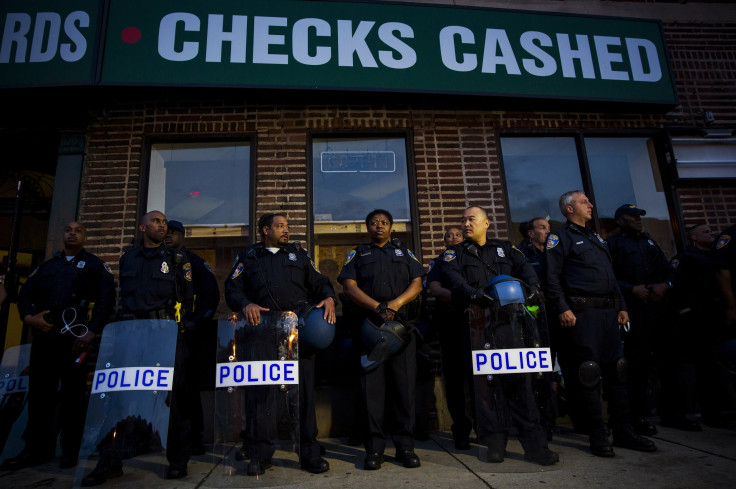Baltimore Riots 2015: Freddie Gray Slammed Head Into Police Van, Causing Fatal Injury, Report Says

As another curfew took effect in Baltimore on Thursday, new information about the arrest and death of Freddie Gray have prompted more questions. On April 12, the 25-year-old Gray suffered a traumatic spinal injury -- which caused his death -- at some point during the first 30 minutes he was in the custody of police officers.
On Thursday, Washington, D.C., news outlet WJLA was briefed on the report that Baltimore police handed over to state-level prosecutors. The report found that Gray suffered the injuries in the back of a police van while he was being transported to Baltimore's Central Booking, further narrowing the scope of the investigation.
The report indicated that a medical examiner found Gray fractured three vertebrae when his head slammed violently into the back of the van, WJLA reported. Police admitted that the officers involved in Gray’s transportation failed to secure him in the back of the van with a seatbelt. They did, however, put leg irons on Gray at one point during the trip because he was being “irate,” according to the van driver. The driver was the only officer involved in the investigation that had yet to give a formal report to police of the April 12 events, although it's unclear why.
Gray’s death sparked violence in parts of Baltimore Monday following his funeral. More than a dozen buildings and at least 140 cars were torched in the chaos, prompting the city to impose a 10 p.m. to 5 a.m. curfew through May 4 and Maryland Gov. Larry Hogan to call in the state’s National Guard.
Unconfirmed reports of arrests made the rounds on social media Thursday night. Tuesday and Wednesday ended without major incidents, but the atmosphere remained tense with a heavy police presence out on the streets and protesters pushing beyond the curfew in defiance of authorities.
As national media descended on Baltimore to cover the protests over the last week, police compiled a report for Maryland State Attorney for Baltimore Marilyn Mosby. Police found that the van transporting Gray made a fourth, previously unknown stop near a grocery store before dropping Gray off at a police station. The owner of the market said officers came to the grocery, asked to see surveillance footage stored on his laptop from April 12 and appeared to record some of what they found. Ironically, the store was looted during Monday’s riots and the laptop was stolen. The owner, Jung Hwang, did not see the footage himself, nor did he see the van outside his store on April 12.
But before that stop, the van picked up another prisoner, who told police in an affidavit that he heard Gray “banging against the walls” in his partitioned part of the van. The prisoner, who is now being held in a jail, said he thought Gray was trying to injure himself, though he admitted that he never actually saw Gray. Some medical experts dispute the idea that Gray could have broken his own neck on purpose. Gray's injuries, they say, are typically seen on victims of major car accidents.
While Gray’s arrest was clearly violent, the latest revelations would clear the arresting officers of being responsible for Gray’s injuries, despite Gray appearing to be hurt and unable to use his legs in two videos showing his arrest. Six officers were suspended with pay for their involvement in Gray’s arrest. It is unclear how many officers knew that Gray was not properly secured in the back of the van, but reports that officers disregarded his pleas for medical help and waited until he fell unconscious to call paramedics suggest they could be found negligent.
© Copyright IBTimes 2024. All rights reserved.






















